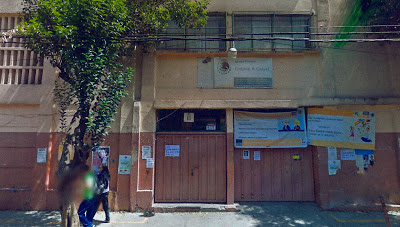 |
| Ezequiel A. Chávez Elementary School, Mexico City Courtesy Google Images, April 2011 |
One Friday afternoon my mother went down to Ezequiel A. Chávez School, a public elementary school on Mirto Street, about four blocks from my grandmother’s home, to register two of my sisters and me for classes. She met with the principal and one of the teachers, who was bilingual and served as interpreter.
The principal, Mrs. Elvira Rangel, happily accepted my sisters on the spot. As for me, she lamented that there was no room in the 4th grade class for another student. My mother asked her to reconsider, not wanting to split us up in different schools. Mrs. Rangel said she was sorry, but there was nothing she could do.
The teacher asked permission to speak. It turned out she was the 4th grade teacher, Ofelia Ortega. “It’s true,” she said, “we have no room – but I will make room for your daughter.”
Further, she offered to tutor me after school at her home, to make sure I understood everything in class. My mother was ecstatic and thanked her profusely.
The following Monday morning, my mother woke us up early. She scrubbed our faces and brushed our hair into ringlets and made sure our white saddle shoes practically sparkled. With butterflies in our stomachs, my sisters and I waved goodbye to her and our baby sister and got into the station wagon for the short ride to our new school. We had been in Mexico City for a couple of weeks and knew only a few phrases in Spanish. We could say hello and how are you and thank you. Beyond that, we wondered, how would we get along?
As my father slowly pulled up to the front of the school on our first morning of class, a very strange thing happened. A little girl pointed to our Illinois “Land of Lincoln” license plates. Someone else ran over to look, and before we knew it, we were mobbed by a crowd of girls, all dressed in immaculate white shirt-dresses with starched sailor collars trimmed in red ribbon, with matching bows at the neck. They swarmed around the car, pushing their noses and mouths against the glass and gesturing wildly as they jumped up and down, squealing, “Miren las güeras!” “Look at the fair-skinned girls,” they were saying.
We later came to understand that our fair faces were a sure sign of our foreignness. (As time progressed, we saw few other Americans in the neighborhood at that time, so we must have been quite the oddity.)
We could not get out of the car because there were so many girls around it, knocking on the windows and firing questions at us in words we could not understand. At first we thought it was funny, but as more faces appeared in the crowd, we began to feel a little frightened. It seemed like an eternity before Mrs. Rangel came out to disperse the students, admonishing them that they – and we – were now tardy. With a nod to my father, she whisked us into the school and to the courtyard, where she lined us up with our respective classmates for the morning assembly.
Copyright © 2013 Linda Huesca Tully
Linda, I just wanted to let you know that your blog post is listed in today's Fab Finds post at http://janasgenealogyandfamilyhistory.blogspot.com/2013/02/follow-fridayfab-finds-for-february-15.html
Have a great weekend!
You are incredibly generous to add my blog to your list of Fab Finds, Jana. I'm truly grateful.
Thanks for visiting – best regards!